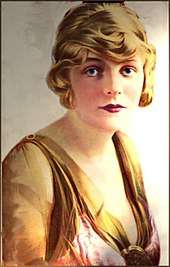Blanche Sweet
Sarah Blanche Sweet (June 18, 1896[1][2][3] – September 6, 1986) was an American silent film actress who began her career in the earliest days of the Hollywood motion picture film industry.
Blanche Sweet | |
|---|---|
.jpg) c. 1915 | |
| Born | Sarah Blanche Sweet June 18, 1896 Chicago, Illinois, U.S. |
| Died | September 6, 1986 (aged 90) New York City, U.S. |
| Occupation | Actress |
| Years active | 1909–1930, 1958–1960 |
| Spouse(s) | |
Early life
Born Sarah Blanche Sweet (though the first name Sarah was rarely used)[4] in Chicago, Illinois, in 1896, she was the daughter of Pearl, a dancer, and Gilbert Sweet, a wine merchant. Her mother died when Blanche was an infant, and she was raised by her maternal grandmother Cora Alexander – and known as Blanche Alexander.[5]
Cora Alexander found her many parts as a young child. At the age of four she toured in a play called The Battle of the Strong with Marie Burroughs and Maurice Barrymore.[5]
A decade later, Sweet acted with Barrymore's son Lionel in a D. W. Griffith-directed film.[6][7] In 1909, she started work at Biograph Studios under contract to director D. W. Griffith. By 1910, she had become a rival to Mary Pickford, who had also started for Griffith the year before.
Rise to stardom

Sweet was known for her energetic, independent roles, at variance with the 'ideal' Griffith type of vulnerable, often fragile, femininity. After many starring roles, her first real landmark film was the 1911 Griffith thriller The Lonedale Operator. In 1913, she starred in Griffith's first feature-length film Judith of Bethulia. In 1914, Sweet was initially cast by Griffith in the part of Elsie Stoneman in his epic The Birth of a Nation but the role was eventually given to rival actress Lillian Gish, who was Sweet's senior by three years. That same year Sweet parted ways with Griffith and joined Paramount (then Famous Players-Lasky) for the much higher pay that studio was able to afford.
Because the Biograph company refused to reveal the names of its actors, the British distributor M. P. Sales billed Sweet as Daphne Wayne.[8]
Throughout the 1910s, Sweet continued her career appearing in a number of highly prominent roles in films and remained a publicly popular leading lady. She often starred in vehicles by Cecil B. DeMille and Marshall Neilan, and she was recognised by leading film critics of the time to be one of the foremost actresses of the entire silent era. It was during her time working with Neilan that the two began a publicized affair, which brought on his divorce from former actress Gertrude Bambrick. Sweet and Neilan married in 1922. The union ended in 1929 with Sweet charging that Neilan was a persistent adulterer.[9][10]

During the early 1920s Sweet's career continued to prosper, and she starred in the first film version of Anna Christie in 1923. The film is also notable as being the first Eugene O'Neill play to be made into a motion picture. In successive years, she starred in Tess of the d'Urbervilles and The Sporting Venus, both directed by Neilan. Sweet soon began a new career phase as one of the newly formed MGM studio's biggest stars.
Sound film and later career
Sweet's career faltered with the advent of talkies. Sweet made just three talking pictures, including her critically lauded performance in 1930's Show Girl in Hollywood, before retiring from the screen that same year and marrying stage actor Raymond Hackett in 1935.[11] The marriage lasted until Hackett's death in 1958.
Sweet spent the remainder of her performing career in radio and in secondary Broadway stage roles. Eventually, her career in both of these fields petered out, and she began working in a Los Angeles department store. In the late 1960s, her acting legacy was resurrected when film scholars invited her to Europe to receive recognition for her work.
In 1975, she was honored with the George Eastman Award for distinguished contribution to the art of film.
In 1980, Sweet was one of the many featured surviving silent film stars interviewed at length in Kevin Brownlow's documentary about the silent film era Hollywood.
Sweet is the subject of a 1982 documentary by Anthony Slide, titled "Portrait of Blanche Sweet," in which she talks of her life and her career. On September 24, 1984, a tribute to Sweet was held at the Museum of Modern Art in New York City. Sweet introduced her 1925 film The Sporting Venus.
Death
Sweet died of a stroke in New York City on September 6, 1986. Her ashes were later scattered within the Brooklyn Botanical Gardens.
Filmography
References
- Social Security Death Index (Death Master File), Blanche Hackett, 18 June 1896 – September 1986.
- U.S. Census, April 15, 1910, State of California, County of Alameda, City of Berkeley, enumeration district 47, page 8A, family 157, Sarah B. Sweet, age 13 years.
- U.S. Census, January 1, 1920, State of California, County of Los Angeles, City of Los Angeles, enumeration district 63, page 6A, family 159, Blanche Sweet, age 23 years.
- American National Biography. 21. p. 200.
- Flom, Eric L. (March 5, 2009). Silent Film Stars on the Stages of Seattle: A History of Performances by Hollywood Notables. McFarland. p. 217. ISBN 978-0-7864-3908-9.
- Davis, James Kotsilibas (1977). Great Times, Good Times: The Odyssey of Maurice Barrymore.
- Pratt, George C. (March 1975). "The Blonde Telegrapher: Blanche Sweet" (PDF). Image. Vol. 18 no. 1. Rochester, N.Y.: International Museum of Photography at George Eastman House Inc. pp. 21–23. Archived from the original (PDF) on October 22, 2012.
- Slide, Anthony (1994). Early American Cinema. Scarecrow Press. p. 141. ISBN 978-0-8108-2722-6.
- "Blanche Sweet Sues Neilan for Divorce". The New York Times. September 24, 1929. p. 28.
- "Decree to Blanche Sweet". The New York Times. October 22, 1929. p. 60.
- "Blanche Sweet Rewed". The New York Times. October 12, 1935. p. 13.
External links
| Wikimedia Commons has media related to Blanche Sweet. |
- Blanche Sweet at the Internet Broadway Database

- Blanche Sweet on IMDb
- Blanche Sweet at AllMovie
- Blanche Sweet at the TCM Movie Database

- Blanche Sweet at Golden Silents
- Some contemporary interviews with Blanche Sweet
- Blanche Sweet at Find a Grave
- Blanche Sweet at New York Public Library, B. Rose Collection
- Photographs and literature on Blanche Sweet
- kinotv.com
- The Girl Who Reads Tennyson Between Scenes - from Motion Picture Magazine, 1916